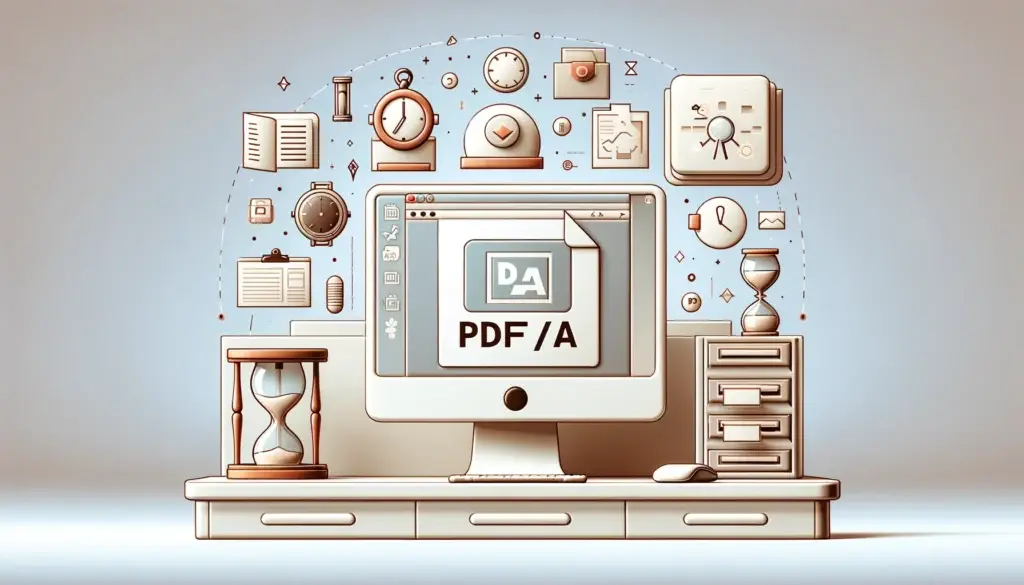
When it comes to preserving electronic documents for long term pdf archiving, it is important to use a standardized format. One such format that has gained significant recognition in the field of digital preservation is PDF/A. The International Organization for Standardization (ISO) developed PDF/A as a specialized version of the PDF format designed specifically for preserving electronic documents. This article will explore how PDF/A impacts the longevity and accessibility of archival digital records and its significance in ensuring these records remain accessible over time.
What is PDF/A?
PDF/A stands for Portable Document Format Archivable. It is an ISO-standardized version of the PDF format that focuses on maintaining the visual appearance and content integrity of electronic documents over time. Unlike regular PDFs, which can be easily modified and edited, PDF/A files are intended for long-term archiving. They are designed to be self-contained and self-descriptive.
One of the key features of PDF/A is that it embeds all the necessary fonts, images, and metadata within the file itself, ensuring that the document will look the same regardless of the software or operating system used to view it. This self-contained nature of PDF/A makes it an ideal archival format for long-term preservation, as it eliminates the risk of dependencies on external resources that may become obsolete or unavailable over time.
The Significance of PDF/A for Digital Preservation and Archiving
Preserving digital documents for the long term is a complex task that involves not only storing the files but also ensuring their accessibility and usability in the future. PDF/A plays a crucial role in this process by providing a standardized archival format that guarantees the authenticity, integrity, and longevity of electronic records stored in a pdf archive.
One of the main challenges in digital preservation is the rapid obsolescence of technology. File formats that were once widely used can quickly become obsolete, rendering the documents stored in those formats inaccessible. PDF/A addresses this issue by providing a format that is independent of specific software or hardware platforms. This means that PDF/A documents can be reliably accessed and rendered decades from now, regardless of the advancements in technology.
Another significant aspect of PDF/A is its support for metadata preservation. Metadata, such as author information, creation date, and document properties, is crucial for understanding the context and provenance of digital records. PDF/A embeds this metadata within the file, ensuring it is preserved over time. This approach makes it easier for future generations to understand and interpret the documents.
Benefits of Using PDF/A for Long-term Digital Preservation and archiving
Using PDF/A for long-term digital preservation offers several benefits:
- Document integrity: PDF/A preserves the content, layout, and visual appearance of electronic documents over time, maintaining the document’s original intent and meaning.
- Platform independence: PDF/A files can be viewed and accessed on any platform or operating system, ensuring long-term accessibility and reducing the risk of format obsolescence.
- Metadata preservation: PDF/A embeds metadata within the file, preserving important information about the document and allowing it to be easily accessed in the future.
- Legal compliance: PDF/A is widely recognized as a reliable format for long-term preservation, making it suitable for meeting legal and regulatory compliance requirements.
- Searchability: PDF/A supports text extraction and indexing, making it easier to search for and retrieve specific information within a document.
Versions and Conformance Levels
PDF/A has evolved through several versions, each building on the previous one to include more features while maintaining the core principles of the standard. Each later version must maintain the previous versions to preserve compatibility:
- PDF/A-1: Based on PDF 1.4, this version is the most restrictive, excluding features like transparency and layers. It includes two levels of conformance: PDF/A-1a (accessible) and PDF/A-1b (basic).
- PDF/A-2: Introduced new features such as JPEG 2000 compression, transparency, and layers. It is based on PDF 1.7 and includes an additional conformance level, PDF/A-2u, which focuses on Unicode text semantics.
- PDF/A-3: Similar to PDF/A-2 but allows embedding of any file type as an attachment, making it useful for archiving documents that require additional files.
- PDF/A-4: The latest version, based on PDF 2.0, continues to expand on the capabilities of earlier versions while maintaining backward compatibility.
Several tools support the creation and conversion of documents to the PDF/A format. Here are some notable ones:
Tools for Creating and Converting to PDF/A
- Mapsoft PDF Hub: This tool converts standard PDF documents to the PDF/A format for long-term archiving:
- PDF/A-1b: Basic compliance for reliable visual reproduction
- PDF/A-2b: Enhanced features including JPEG2000 and transparency
- PDF/A-3b: Allows embedding of non-PDF/A files
- Adobe Acrobat: Adobe integrated PDF/A support starting from Acrobat 8, allowing users to create PDF/A-compliant documents directly from their software.
- Microsoft Office: Microsoft offers a plug-in for Office 2007 and later versions that enables users to save documents as PDF/A directly from Office applications
- PDFelement: This tool allows users to validate and convert documents to PDF/A, supporting various standard versions like PDF/A-1a and PDF/A-1b.
- PDF Studio: This tool provides advanced features for validating and creating PDF/A documents, including a “Preflight” mode for ensuring compliance with different PDF/A standards.
- Apryse PDF/A Library: Offers a comprehensive solution for PDF/A conversion and validation on multiple platforms, including Windows, Linux, and macOS. It also provides a command-line tool, PDF/A Manager, for batch processing.
- PDF2Go: Provides an online tool for converting PDF files to PDF/A format, ensuring compliance with ISO standards.
These tools are widely used across various industries to ensure that documents are preserved in a format that guarantees long-term accessibility and compliance with archival standards.
Conclusion
PDF/A has revolutionized the field of long-term pdf digital archiving by providing a standardized format that ensures the authenticity, integrity, and accessibility of electronic documents. Its self-contained nature, platform independence, and support for metadata preservation make it an ideal choice for organizations and institutions looking to preserve their digital records for future generations. By adopting PDF/A, we can ensure that our valuable electronic documents will remain accessible and usable for years to come.
ISO Standards
The ISO standards for PDF/A, which is a format designed for long-term preservation of electronic documents, are part of the ISO 19005 series. Here are the key parts of the standard:
- ISO 19005-1:2005: This is the original PDF/A standard, known as PDF/A-1, which is based on PDF 1.4. It defines how to use PDF for long-term preservation of electronic documents, ensuring that documents can be reliably reproduced in the future. It includes two conformance levels: PDF/A-1a (accessible) and PDF/A-1b (basic).
- ISO 19005-2:2011: Known as PDF/A-2, this standard is based on PDF 1.7 and introduces new features like JPEG 2000 compression, transparency, and layers. It also includes an additional conformance level, PDF/A-2u, which focuses on Unicode text semantics.
- ISO 19005-3:2012: This version, PDF/A-3, is similar to PDF/A-2 but allows any file type to be embedded as an attachment, which is useful for archiving documents that require additional files.
- ISO 19005-4:2020: Known as PDF/A-4, this version is based on PDF 2.0 and introduces the PDF/A-4e conformance level, which supports interactive 3D models for engineering workflows.
These standards can be purchased from the ISO website as shown by the above links, as they are protected by copyright and not available for free distribution.


